
Pivot launched the Mach 429 Trail last year as a do-it-all trail bike. With 116mm of rear travel, 130mm front, and 29″ wheels, it looks to be in “Goldilocks” territory, with just enough squish at both ends–at least, on paper.
Specs

While it shares part of its name with Pivot’s XC-oriented 429SL, the 429 Trail is a wholly different bike. It has more travel, a revised suspension linkage, a slacker head tube angle, and a longer wheelbase–just to name a few of the major differences. Pivot chose to go with Boost spacing on both the rear triangle and the fork, which gives customers the option to run 27.5+ wheels. They were kind enough to include a set of 27.5+ wheels and tires so I could test the bike with both setups.

There are eight different build kits available for the 429 Trail, so you can have your choice between Shimano and SRAM, single ring or two-by drivetrains, and 29″ or plus wheels. For suspension, however, there’s only one option–Fox. Pivot is a big fan of the stuff. The bike I rode was the XT/XTR Pro 2x with the DT Swiss XMC 1200 Carbon wheel and LEV dropper post upgrades.
Spec highlights:
- Frame: Mach 429 Carbon Trail
- Shock: Fox Float DPS Kashima
- Fork: Fox 34 Factory 130mm, Kashima, Boost 110
- Drivetrain: 2×11 Shimano XT/XTR
- Brakes: XT
- Dropper Post: LEV Integra (upgrade)
- 29″ Wheels: DT Swiss XMC 1200 Carbon (upgrade)
- 27.5+” Wheels: DT Swiss XM 551 rims / DT Swiss 350 hubs
- 29″ Tires: Maxxis Tomahawk
- 27.5+” Tires: Maxxis Ikon+ and Rekon+
- Price: $5,400 (without wheel upgrade)
The Maxxis Tomahawk tires are not currently a stock offering. Pivot specs the 29×2.25″ Ardent, a favorite of many, but not one I personally get along with.
At around 30lbs for the size large it’s not a light bike, but it hides that weight well. Honestly, I was surprised it weighed as much as it did. I like to make a guess before throwing a bike on the scale, and I was two pounds off on the Pivot. That said, I never felt its heft to be detrimental.
Geometry

Most of the numbers above put the 429 Trail in the same ballpark as similar bikes from their competitors–think Santa Cruz Tallboy, Kona Process 111, Ibis Ripley, Specialized Camber, etc. The exceptions would be the reach (short) and stack (high) figures. I found the riding position to be neutral and comfortable, even after hours in the saddle.
On the Trail (Literally)
Most of my “shakedown rides” tend to be atypical. Instead of an easy cruise around a familiar trail, I like to launch directly into the fire. My first ride on the 429 Trail during the Maxxis Appalachian Summit in early April was no exception. A few folks at the Summit wanted to get a long ride in, so I suggested the Brutal Loop. The 35-mile loop has around 7,000 feet of elevation gain covering gravel roads, swooping descents, steep singletrack climbs, and plenty of technical elements. It’s Georgia mountain biking at its finest, and a proper test loop for any bike.

Pivot had set the bike up with Maxxis’ Minion+ tires. Even with those huge tires, the bike didn’t feel sluggish on the 13 miles of gravel that the ride starts with. After getting over the initial novelty of the plus tires, “Man these things look huge!” I forgot about them altogether. My first impression was that the Trail is comfortable and capable. All the subsequent miles I’ve put on the bike since only confirm those sentiments.
Click over to page 2 to keep reading!











1 Comments
Jul 16, 2016